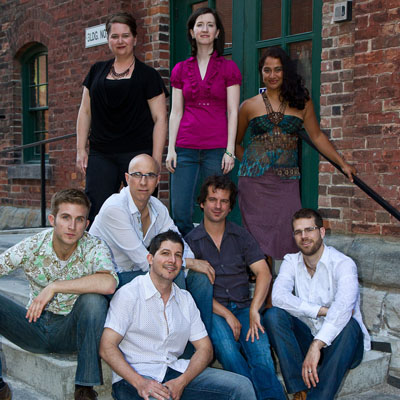Retrocity
Saturday 26th January, 1:45pm
Kings Place / Hall One

Canadian favourites Retrocity cover musical vintages of all kinds from jazz to soul to funk, capturing an astonishing and utterly unique range of instrumental imitation.
Discover 'Strange Animal'
Retrocity captures the spirit of the eighties with the Canadian pop classic "Strange Animal" originally by Gowan.
There are several different ways to approach arranging an a cappella version of a popular song. The most common would be for arrangers to either put their own unique twist on it, or to replicate the original version as accurately as possible. In this case Retrocity have used the second approach, and it's a great example of this approach being done well.
Enjoy the full song
The beginning of the piece is very similar to the original song: it starts with the high soprano's sustained "ooh" notes, which imitate the synthesiser effect used in Gowan’s original recording, before moving to the nasal "wow" sounds in the tenor parts that mimic the distorted guitar parts.
Listen for the high "oohs" and then the guitar-like "wow"s (00:14)
This is soon developed into a similarly nasal "ban na na" to mark the change in guitar tone. Listen to how effectively these nasal sounds capture the sound of the guitar. You can also hear how well the singers can still blend together by choosing to use the same sonorities for their parts at times.
The rhythm of these guitar parts are reinforced with the punchy bass, and the bass part is particularly prominent in the verses. Again it is almost as an exact replication of the original (which is characteristic of eighties music) - clearly Retrocity are very familiar with this style! Not only is the bass high in the mix, adding to the drive and groove of the song, but the sounds the group create are mostly very "staccato" (punchy and short), replicating the distinctive bass guitar sound of this genre.
Listen for the prominent bassline (00:27)
The words "How can I get enough" give an example of a rare homophonic section in this arrangement, with all the singers combining their voices to deliver that line together:
Listen to how the voices combine together here (01:08)
Notice how the slight silent pause beforehand makes this moment stand out particularly well. It also contrasts with the polyphonic textures (voices singing differently from each other) throughout the rest of the song helping to launch the listener into the catchy chorus.
In this quieter section later in the song, listen for the percussive "chucka chucka" effect which fills out the sound - whilst also representing the tambourine and shaker heard in Gowan’s original version:
Listen to the "chucka chucka" percussive sounds (02:35)
Other notable percussion sounds include the snare drum sound which features throughout the arrangement. The compression effect applied to this in the song's mix helps to create a consistent noise similar to that found on an eighties drum machine.
One of the reasons a cappella music is so popular is because audiences (a.k.a. "acalovers"!) enjoy the variety of ways their favourite songs can be covered using only the human voice. In "Strange Animal" Retrocity successfully capture the diverse selection of sounds from the original song; particularly impressive considering the large range of synthesised instruments in the original! The listener can almost forget that they are in fact using only their voices to achieve these sounds...
Written by Henry Southern
Track Trivia
• "I got a fever...": the cowbell sounds from the introduction are a combination of Suba singing "bok-book, bok-book", and Ross clicking his teeth together... in tune. Ross has this freakish ability to click his teeth together and change the size of his mouth cavity to tune the notes (this is the same guy who did all the harmonica sounds on the Cadence records, so no surprise there!) Add some massive EQ and a gated reverb and voila... aca-cowbell!
Listen to the "aca-cowbell" (00:00)
• Lanie gets her first "wolf-howl" credit!
• Despite its high production value, this was recorded in a much more oldskool manner, including some group tracking and longer takes, rather than bar-by-bar recording. The drums were recorded in one take. There is no autotune on nearly all of the tracks: what you hear is what we sang! We recorded most of the parts in one day, and mixed in one day.
• This is a "live arrangement": ask us nicely, and we’ll sing it for you in London!
Strange Animal
Performed by Retrocity: Dylan Bell, Daniel Galessiere, Jenn Hadfield, Aaron Jensen, Ross Lynde, Art Mullin, Suba Sankaran, Lanie Treen.
Lead: Dylan Bell.
Arranged by Dylan Bell.
Recorded by Art Mullin at RMW Music.
Edited, mixed and mastered by Dylan Bell at FreePlay Studios.
